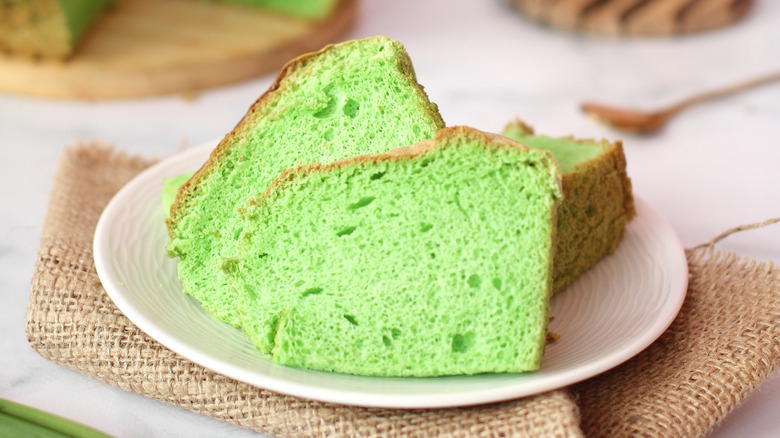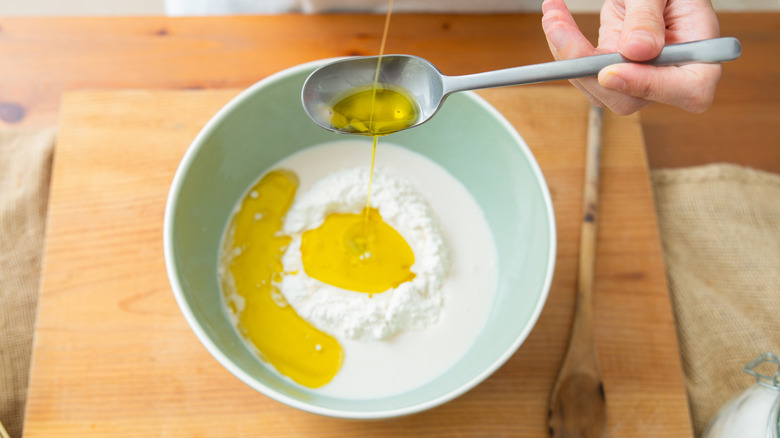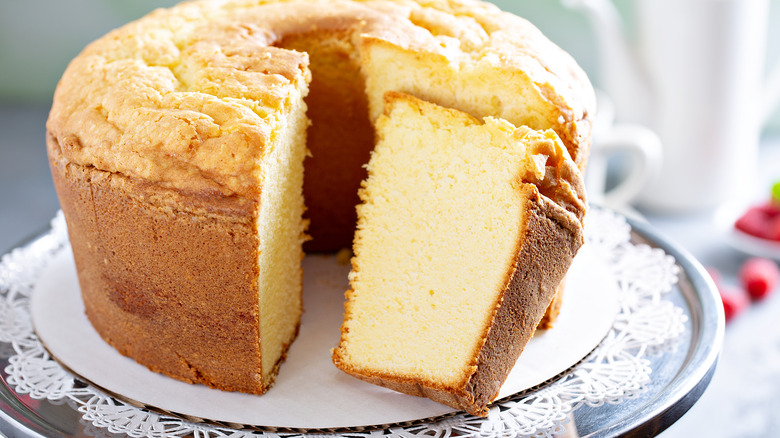For Ultra-Soft Cakes, Try The Tang Mian Method And Heat Oil First
Strolling through an Asian bakery, rows of not-too-sweet treats like egg tarts and soft mochi beckon you from behind their glass display, but it's a tall and fluffy pandan chiffon cake that catches your eye. You can already tell this cake is soft and moist, and when pressed, it'll probably bounce right back like the spawn of a cloud and memory foam. Wipe that drool, please.
Cakes like this one often owe their ultra-soft, cottony texture to a technique called tang mian, translated as cooked dough or hot flour in Mandarin. This Asian baking technique mirrors the tangzhong method of making soft and tender milk bread.
Like the tangzhong method (which involves cooking flour with hot water first, not oil or fat, to make a roux, later added to the bread dough), the tang mian method involves mixing hot butter or oil with flour to form a roux-like paste. Breaking down the baking science, the hot oil, when bound to the flour, prevents the batter from forming too much gluten. Subsequently, the batter becomes a sponge that absorbs more liquid, producing an ultra-soft and often fluffy cake with an extraordinarily tender crumb.
Now, while the origins and history of the tang mian method appear unclear, the technique itself has been widely practiced in Asian baking.
Mixing hot oil with flour is the secret to ultra-soft cakes
To employ the tang mian method to make the softest cakes, begin by heating butter or oil. You can do this in a microwave in 20-second bursts (or over the stove in a saucepan) until the oil or melted butter is heated to about 176 degrees Fahrenheit. Then add the cake or all-purpose flour and whisk until combined; a smooth and runny glue-like paste is what you're looking for.
Then, other cake batter ingredients like sugar, vanilla extract, egg yolks, and milk are mixed into the paste. What makes tang mian fascinating is, once again, the baking science behind it all: "Cooking" the flour first with the fat impedes excessive gluten formation, and gluten, a protein that provides structure to baked goods, tends to make cake crumb tougher and denser if overdeveloped. For bread, you'd want more gluten to develop — but for cake, you often want the opposite.
You'd think by halting gluten formation, cakes made with the tang mian method would fall flat. In Asian baking, the tang mian method is often paired with mechanical leavening, or using aerated and whipped egg whites to give cakes volume. Thus cakes baked with the tang mian method often achieve unparalleled lightness, fluffiness, and tenderness.
Tang mian is a game changer for home bakers
We encourage you to employ the tang mian technique in your favorite cake recipes; it'll be quite transformative. Tang mian enhances the texture of an array of cakes, from the classic vanilla sponge cake or angel food cake, to oil-based cakes like carrot cake or zucchini bread. It even makes meringue-based cakes delightfully cloud-like.
The magic of tang mian doesn't stop at texture alone; tang mian is one reason why Asian bakery cakes retain moisture and stay softer for days. Thus with the tang mian method, your homemade cakes may achieve the same long-lasting freshness and softness, even days after baking.
Integrating this method into your baking routine is like uncovering a well-kept secret ingredient, one that has been the backbone of the ultra-soft cakes found in Asian bakeries across the globe. Perhaps on your next visit to an Asian bakery, you'll find yourself grinning goofily, knowing that you too are privy to this secret: the fascinating and science-based tang mian method.


